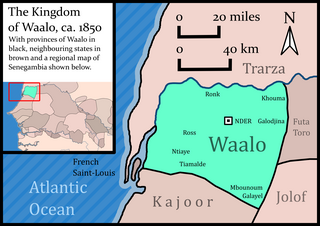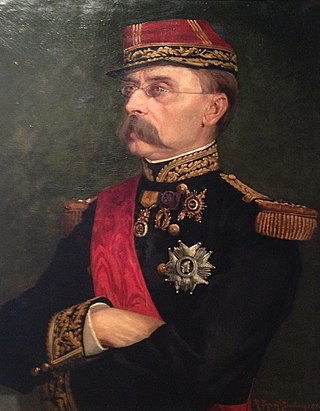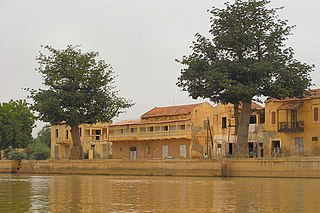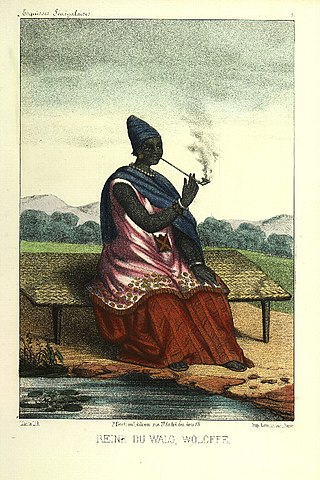
Waalo was a kingdom on the lower Senegal River in West Africa, in what is now Senegal and Mauritania. It included parts of the valley proper and areas north and south, extending to the Atlantic Ocean. To the north were Moorish emirates; to the south was the kingdom of Cayor; to the east was Jolof.

Saint-Louis or Saint Louis, is the capital of Senegal's Saint-Louis Region. Located in the northwest of Senegal, near the mouth of the Senegal River, and 320 kilometres (200 mi) north of Senegal's capital city Dakar. It had a population of 254,171 in 2023. Saint-Louis was the capital of the French colony of Senegal from 1673 until 1902 and French West Africa from 1895 until 1902, when the capital was moved to Dakar. From 1920 to 1957, it also served as the capital of the neighboring colony of Mauritania.

Louis Léon César Faidherbe was a French general and colonial administrator. He created the Senegalese Tirailleurs when he was governor of Senegal.

The siege of Fort Medina took place in 1857 at Médine, on the left bank of the Senegal River in present-day Mali. The Toucouleur forces of Omar Saidou Tall unsuccessfully besieged native and French colonial troops commanded by Paul Holle. After 97 days of siege, a relief force under French Governor Louis Faidherbe lifted the siege and forced the Toucouleur army to retreat.

Dagana is a town and urban commune situated in the Saint-Louis Region of Senegal and it is the capital of the Dagana Department. Dagana borders Mauritania across the Senegal river.
The Franco-Trarzan War of 1825 was a conflict between the forces of the new emir of Trarza, Muhammad al Habib, and France, ruled at the time by Charles X and the ultra comte de Villèle. In 1825, Muhammad attempted to establish control over the French-protected Waalo Kingdom, then located south of the Senegal River, by marrying the heiress to the kingdom. The French responded by sending a large expeditionary force that crushed Muhammad's army. The war incited the French to expand to the north of the Senegal River.

The Emirate of Trarza was a pre-colonial state in what is today southwest Mauritania. It has survived as a traditional confederation of semi-nomadic people to the present day. Its name is shared with the modern Region of Trarza. The population, a mixture of Berber tribes, had been there for a long time before being conquered in the 11th century by Hassaniya Arabic speakers from the north.
Mö Mboj Maalik Mboj was the last King of Waalo, a pre-colonial kingdom in what is now northern Senegal. He succeeded to the throne as Brak in 1840 and ruled until Waalo was conquered by the French in 1855.

Faidherbe Bridge is a road bridge over the Senegal River which links the island of the city of Saint-Louis in Senegal to the African mainland. The metal bridge is 507.35 m (1,664.5 ft) long and 10.5 m (34 ft) wide, weighing 1,500 t. It has eight spans, of which the longest five are 78.26 m (256.8 ft).

The period from the mid-nineteenth to mid-twentieth centuries is the colonial period in Mauritania.
Colonel Julien-Désiré Schmaltz or Julien Schmaltz was a French colonial administrator and governor of Senegal from 1816 to 1820.
The French conquest of Senegal started in 1659 with the establishment of Saint-Louis, Senegal, followed by the French capture of the island of Gorée from the Dutch in 1677, but would only become a full-scale campaign in the 19th century.
Portendick is an abandoned coastal city in western Mauritania. The name is a corruption of the Portuguese name Porto d'Arco. It was located in the Ouad Naga Department of Trarza Region.

The Battle of Logandème was an uprising led by the Serer King Maad a Sinig Kumba Ndoffene Famak Joof, king of Sine, against the French Empire. The battle took place at Logandème which was a part of Sine at the time. The battle was also a revenge attack against the Serer people after their resounding victory against France at the Battle of Djilass on 13 May 1859. It was the first time that France decided to employ cannonball in the Senegambia.

Ndaté Yalla Mbodj, also known as Ndateh Yalla Mbooj, was the last Lingeer (Queen) of Waalo, a Jolof kingdom located in what is now northwest Senegal. During her reign, she fought against French colonization and Moorish invasion of her kingdom. Ndaté Yalla and her sister Ndjeumbeut Mbodj were two of the most powerful women of 19th century Senegalese dynastic history.
The following is a timeline of the history of the city of Saint-Louis, Senegal.
Njembot Mbodj was a Lingeer (Queen) of Waalo, a Senegambian precolonial kingdom which is now part of present-day Senegal.

Paul Holle (1807-1862) was a mixed-race French soldier and writer, best known for his staunch defense of Fort-Médine against the besieging Toucouleur army of El Hadj Omar Tall between April and July 1857.
The Battle of Dioubouldou was fought on 25 February 1855 between French forces of Colonel Louis Faidherbe and the combined Waalo and Trarza forces under Queen Ndaté Yalla Mbodj.
N'Der is a small town on the western shore of the Lac de Guiers, in northern Senegal. It was the third and last capital of Waalo until the annexion of the kingdom by France in 1855.











